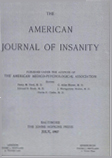THE MECHANISM OF FRACTURES OF THE VERTEBRAL BODIES
Abstract
1. A study of the anatomy and of the practical considerations of the spine shows that fractures of the vertebral bodies are usual at those areas of the spine that are mechanically weak or exposed to the effects of traumatism.
2. Metrazol acts to cause convulsions attendant with very forcible muscular contractions sufficient to fracture the bodies of the vertebræ in the mid-dorsal region which is anatomically and dynamically vulnerable. The localization differs from the more usual sites of fracture because of a modification of the type of stress and strain peculiar to the muscular contractions caused by metrazol injections and their effects on the anatomy of the parts affected. The degree of injury varies directly with the force of the muscular contractions and inversely with the resistance offered by, or the strength of, the vertebral bodies. The force of the muscular contractions and the energy expended is so great that a convulsion continuing for 90 seconds may exhaust the patient for 8 to 24 hours.
3. The mid-dorsal area of the spine is anatomically vulnerable and fractures occur at this site following metrazol therapy because the site is midway between the forward physiological curves of the cervical area above and the lumbar below. The degree of flexion occurs through an arc sufficiently small to make the mid-dorsal spine the recipient of its greatest effects. The vertebral bodies are here wider anteriorly while the discs are smaller, less resilient and more narrow anteriorly; and the dynamic center of the flexor contracting force of the trunk muscles is at this level.
4. The number of metrazol injections has no relation to the number of vertebral bodies fractured or to the degree of wedging. The extent and degree of injury are rather dependent upon the intensity of the muscular contractions, due to any one particular convulsive treatment, and the strength of the spine to withstand the shock. Undoubtedly if a fracture occurs early in the course of treatment and if treatments continue without the prophylactic measures recommended, increased wedging of the vertebræ may obtain.
5. Rupture of the nucleus pulposus with protrusion into the neural canal is most unusual following fractures of the vertebral body.
6. No practical type of mechanical fixation can prevent injury to the vertebral bodies.
7. Prophylaxis is possible, and the use of spinal anesthesia given prior to the metrazol injections as suggested by Hamsa and Bennett is recommended.
8. If fracture occur, immobilization of the trunk between treatments and reduction of the deformity, if it is present, with fixation in a plaster jacket for six months after the treatments are completed should result in entire healing of the fractures.
Access content
To read the fulltext, please use one of the options below to sign in or purchase access.- Personal login
- Institutional Login
- Sign in via OpenAthens
- Register for access
-
Please login/register if you wish to pair your device and check access availability.
Not a subscriber?
PsychiatryOnline subscription options offer access to the DSM-5 library, books, journals, CME, and patient resources. This all-in-one virtual library provides psychiatrists and mental health professionals with key resources for diagnosis, treatment, research, and professional development.
Need more help? PsychiatryOnline Customer Service may be reached by emailing [email protected] or by calling 800-368-5777 (in the U.S.) or 703-907-7322 (outside the U.S.).



